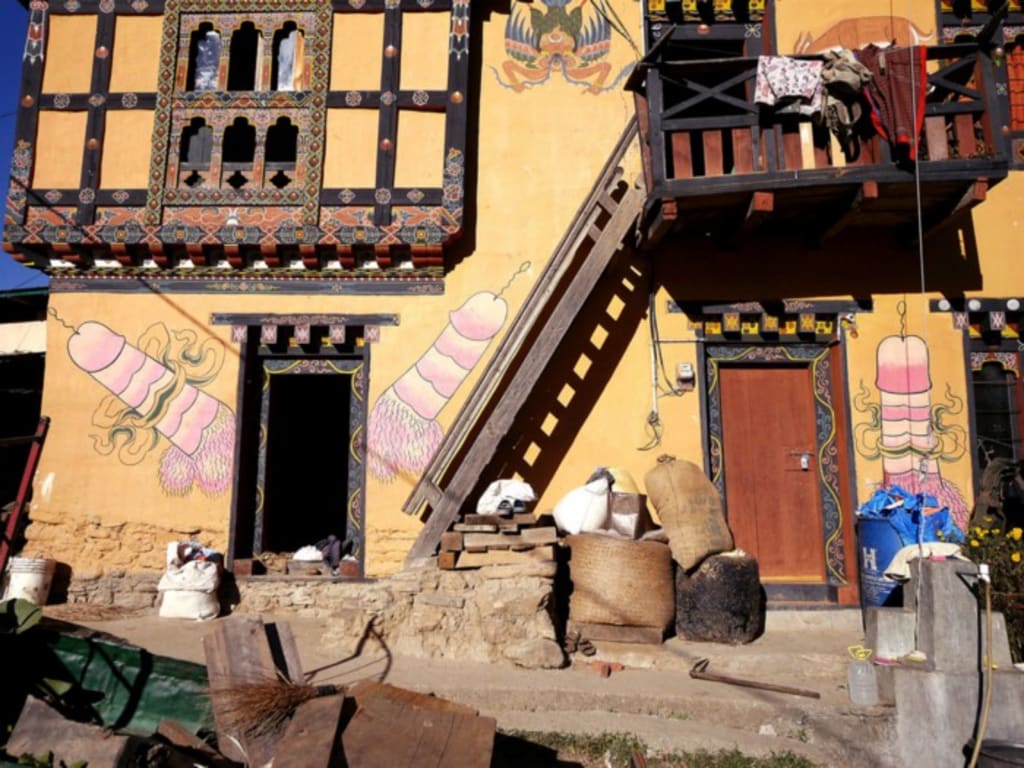Why Bhutanese People Paint Erect-Penis on Their Homes
The best wine lies at the bottom of the pail, and happiness lies below the navel

Isn't it a little awkward to see houses painted with phallus?
It was a little uneasy for me, at least, while I was visiting Bhutan, a country full of happy people, in June 2019.
In Bhutan, you will find paintings of an erect penis in many places, especially in rural areas. It is on the wall of their houses, curved in woods, metal, stone, and cloth, installed above doorways, in the souvenir shops, and even you can see it as a direction-signage.
Sometimes, you will find erect penises enveloped with a dragon, spitting fire with dark yellow or pastel pink in colors. Sometimes, you will see eyes painted on the ejaculating penis. And it can be a shock at first sight for tourists who hardly know anything about this unique culture.
Why are phallus painted everywhere?
In Bhutan, the phallus is an esoteric symbol that offers protection from evil and brings good luck. It's an age-old belief of Bhutanese people. They see phallus as a symbol of fertility as well.
This tradition of phallic worship came from the 15th-century Buddhist teacher, Drukpa Kunley (1455–1529), who popularly known as "Divine Madman" for his unorthodox and bizarre ways of teaching.
Kunley's story is quite interesting. He migrated from Tibet and extensively traveled across Bhutan. Though he was a disciple of Pema Lingpa and was trained in Ralung Monastery in Tibet, he had a crazy fondness for women and wine. So, it's not surprising that he adopted an unorthodox way of teaching Buddhism associated with the erect-penis.
He is quoted often as saying, "The best wine lies at the bottom of the pail, and happiness lies below the navel."
He introduced sexual debauchery and phallic obsession to Bhutan around 1499 and originated the legend of painting erect-penis on walls and flying hanging phalluses from roof-tops to drive away evil spirits.
The phallic art is supposed to be Kunley's organ and called the "Thunderbolt of Flaming Wisdom" as it drives away demons and evil spirits. His bizarre way of teaching Buddhism attracts many followers, though it was a shock to the clergymen.
It is said that he is, perhaps, the only saint in history who is exclusively identified with phallus and its creative power.
Cultural significance of phallus paintings
Though the phallus paintings are somewhat embarrassing and not a good fit for this democratic, constitutional monarch of modern Bhutan, it still remains a staple of Bhutanese culture. You may find Bhutanese women wearing phallus necklaces as well.
People use it as a cultural or religious symbol. They associate phallus paintings with fertility, good luck and believe that it will keep them safe from evil spirits or demons.
Each year at a certain period, many communities in eastern Bhutan worship phalluses with flowers, ara (red-colored hooch), and milk. Again, in central Bhutan, a wooden phallus is dipped into the cups of drinks before offering them to the guests.
Moreover, when people inaugurate their new homes, they perform an elaborate phallic ritual that constitutes placing four phalluses on the four eaves of the house facing the four directions and one inside the house. Then, a young and virgin girl leads a dancing and singing troupe carries the basket, and circumambulates the house thrice.
Chimi Lakhang monastery, Bhutan. Photo by Bernard Gagnon from Wikimedia CommonsIt is to mention, the Chimi Lhakhang monastery was built in 1499, in honor of Drukpa Kunley. The original wooden symbol of phallus that Kunley brought from Tibet is kept inside the monastery.
It also has a silver-handled phallus, used to bless people who visit the monastery on pilgrimage, particularly women seeking blessings to beget children.
To Conclude
Though the rural Bhutanese people still use phallus as a cultural and spiritual symbol, now urban ones are getting less interested in painting them on their walls. It is also not painted in community temples and dzongs where the lamas and Buddhist monks practice Buddhism.
So, while visiting Bhutan, if you encounter this graphical representation of male genitalia painted on the walls, don't feel awkward.
This phallus symbol is sacred to them as it represents a unique story with historical, cultural, and spiritual significance.
---
Thank you for reading.
* The article was previously published on Medium (link)
About the Creator
S M Mamunur Rahman
Freelance Writer | Blogger | Editor of The Masterpiece






Comments
There are no comments for this story
Be the first to respond and start the conversation.